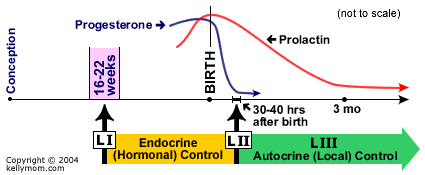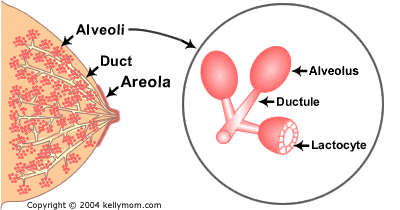How Does Milk Production Work?
by Kelly
Bonyata

Reprinted with permission
To understand
how to effectively increase milk supply, we need to look at how
milk production works...
| For
the most part, milk production is a "use it or lose it"
process. The more often and effectively your baby nurses, the
more milk you will make. |
In
the Beginning...
Endocrine
(Hormonal) Control of Milk Synthesis — Lactogenesis I &
II
Milk production
doesn’t start out as a supply and demand process. During
pregnancy and the first few days postpartum, milk supply is hormonally
driven – this is called the endocrine control system.
Essentially, as long as the proper hormones are in place, mom
will start making colostrum about halfway through pregnancy (Lactogenesis
I) and her milk will increase in volume (Lactogenesis II) around
30-40 hours after birth.
During the
latter part of pregnancy, the breasts are making colostrum, but
high levels of progesterone inhibit milk secretion and keep the
volume "turned down." At birth, the delivery of the
placenta results in a sudden drop in progesterone/estrogen/HPL
levels. This abrupt withdrawal of progesterone in the presence
of high prolactin levels cues Lactogenesis II (copious milk production).
Other hormones (insulin, thyroxine, cortisol) are also involved,
but their roles are not yet well understood. Although biochemical
markers indicate that Lactogenesis II commences approximately
30-40 hours after birth, mothers do not typically begin feeling
increased breast fullness (the sensation of milk "coming
in") until 50-73 hours (2-3 days) after birth.
These first
two stages of lactation are hormonally driven – they
occur whether or not a mother is breastfeeding her baby.

Established
Lactation...
Autocrine
(Local) Control of Milk Synthesis — Lactogenesis III
After Lactogenesis
II, there is a switch to the autocrine (or local) control system.
This maintenance stage of milk production is also called Lactogenesis
III. In the maintenance stage, milk synthesis is controlled at
the breast -- milk removal is the primary control mechanism for
supply. Milk removal is driven by baby's appetite. Although hormonal
problems can still interfere with milk supply, hormonal levels
play a much lesser role in established lactation. Under normal
circumstances, the breasts will continue to make milk indefinitely
as long as milk removal continues.
By understanding
how local/autocrine control of milk synthesis works, we can gain
an understanding of how to effectively increase (or decrease)
milk supply.
What
Does Current Research Tell Us About Milk Production?
Current research
suggests that there are two factors that control milk synthesis:
Milk
contains a small whey protein called Feedback
Inhibitor of Lactation (FIL) – the role of FIL appears
to be to slow milk synthesis when the breast is full. Thus milk
production slows when milk accumulates in the breast (and
more FIL is present), and speeds up when the breast is
emptier (and less FIL is present).

The hormone
prolactin must be present for milk synthesis to occur. On the
walls of the lactocytes (milk-producing cells of the alveoli)
are prolactin receptor sites that
allow the prolactin in the blood stream to move into the lactocytes
and stimulate the synthesis of breastmilk components. When the
alveolus is full of milk, the walls expand/stretch and alter the
shape of prolactin receptors so that prolactin cannot enter via
those receptor sites – thus rate of milk synthesis decreases.
As milk empties from the alveolus, increasing numbers of prolactin
receptors return to their normal shape and allow prolactin to
pass through - thus rate of milk synthesis increases. The prolactin
receptor theory suggests that frequent milk removal in
the early weeks will increase the number of receptor sites. More
receptor sites means that more prolactin can pass into the lactocytes
and thus milk production capability would be increased.
Both
of the above factors support research findings that tell us:
 |
FULL
Breast |
= |
SLOWER
Milk
Production |
|
 |
EMPTY
Breast |
= |
FASTER
Milk
Production |
|
Research indicates
that fat content of the milk is also determined by how empty the
breast is (emptier breast = higher fat milk), rather than by the
time of day or stage of the feed.
How
Does Milk Supply Vary Throughout the Day?
Earlier
researchers observed that milk volume is typically greater in
the morning hours (a good time to pump if you need to store milk),
and falls gradually as the day progresses. Fat content tends to
increase as the day progresses (Hurgoiu V, 1985). These observations
are consistent with current research if we assume the researchers
were observing babies with a fairly typical nursing pattern, where
baby has a longer sleep period at night and gradually decreases
the amount of time between nursing as the day progresses.
 Storage
capacity: Another factor that affects milk production and
breastfeeding management is mom’s milk
storage capacity. Storage capacity is the amount of milk
that the breast can store between feedings. This can vary widely
from mom to mom and also between breasts for the same mom. Storage
capacity is not determined by breast size, although breast size
can certainly limit the amount of milk that can be stored. Moms
with large or small storage capacities can produce plenty
of milk for baby. A mother with a larger milk storage capacity
may be able to go longer between feedings without impacting milk
supply and baby's growth. A mother with a smaller storage capacity,
however, will need to nurse baby more often to satisfy baby’s
appetite and maintain milk supply since her breasts will become
full (slowing production) more quickly. Storage
capacity: Another factor that affects milk production and
breastfeeding management is mom’s milk
storage capacity. Storage capacity is the amount of milk
that the breast can store between feedings. This can vary widely
from mom to mom and also between breasts for the same mom. Storage
capacity is not determined by breast size, although breast size
can certainly limit the amount of milk that can be stored. Moms
with large or small storage capacities can produce plenty
of milk for baby. A mother with a larger milk storage capacity
may be able to go longer between feedings without impacting milk
supply and baby's growth. A mother with a smaller storage capacity,
however, will need to nurse baby more often to satisfy baby’s
appetite and maintain milk supply since her breasts will become
full (slowing production) more quickly.
 Think of storage capacity as a cup - you can easily drink a large
amount of water throughout the day using any size of cup
- small, medium or large - but if you use a smaller cup it will
be refilled more often.
Think of storage capacity as a cup - you can easily drink a large
amount of water throughout the day using any size of cup
- small, medium or large - but if you use a smaller cup it will
be refilled more often.What
Does the Research Tell Us About Increasing Milk Supply?
Milk is being
produced at all times, with speed of production depending upon
how empty the breast is. Milk collects in mom's breasts between
feedings, so the amount of milk stored in the breast between feedings
is greater when more time has passed since the last feed. The
more milk in the breast, the slower the speed of milk production.
To
speed milk synthesis and increase daily milk production,
the key is to remove more milk from the breast and to do this
quickly and frequently, so that less milk accumulates in the breast
between feedings:
 |
EMPTY
Breast |
= |
FASTER
Milk
Production |
|
In practice,
this means that a mother who wishes to increase milk supply should
aim to keep the breasts as empty as possible
throughout the day.
To accomplish
this goal and increase milk production:
- Empty
the breasts more frequently (by nursing more often and/or adding
pumping sessions between nursing sessions)
- Empty
the breasts as thoroughly as possible at each nursing/pumping
session.
To better
empty the breasts:
- Make
sure baby is nursing efficiently.
- Use breast
massage and compression.
- Offer
both sides at each nursing; wait until baby is finished with
the first side before offering the second. Switch nursing may
be helpful if baby is not draining the breast well.
-
Pump after nursing if baby does not adequately soften both breasts.
If baby empties the breasts well, then pumping is more useful
if done between nursing sessions (in light of our goal
to keep the breasts as empty as possible).
See
Also
Frequently
Asked Questions about Milk Production
How
Does Foremilk and Hindmilk Work?
Note:
The graphics above are copyrighted. Do not use without express
written permission.
Many thanks
to Denise Fisher of Health
e-Learning for the valuable feedback!
Additional
Information
How
Mother's Milk is Made by Linda J. Smith,
BSE, FACCE, IBCLC.
Anatomy
of the Breast and How the Breast Makes Milk by Marie Davis,
RN, IBCLC
How
the breasts make and deliver milk from AskDrSears.com
Examining
the Evidence for Cue Feeding Breastfed Infants by Lisa Marasco,
BA, IBCLC and Jan Barger, MA, RN, IBCLC
Finish
the First Breast First by Melissa Clark Vickers
Human
Milk and Lactation by Carol L Wagner, MD
References
Cox DB, Owens
RA, Hartmann PE. Studies
on Human Lactation: The Development of the Computerized Breast
Measurement System. June 1998.
Cregan MD,
Mitoulas LR, Hartmann PE. Milk
prolactin, feed volume and duration between feeds in women breastfeeding
their full-term infants over a 24 h period. Exp Physiol. 2002
Mar;87(2):207-14.
Hartmann PE.
Regulation
of Milk Synthesis in Women. 17 mars 2000.
Hartmann PE,
Owens RA, Cox DB, Kent JC. Breast
development and control of milk synthesis. Tokyo, Japan: United
Nations University Press; 1996 Dec. 17(4).
Hartmann PE,
Prosser CG. Physiological
basis of longitudinal changes in human milk yield and composition.
Fed Proc. 1984 Jun; 43(9): 2448-53.
Hurgoiu V,
Marcu A, Sopon E, Olariu M. Dynamics
of the composition of lipids in human milk during lactation.
[French]. Pediatrie. 1985 Apr-May;40(3):201-5.
Marasco L,
Barger J. Cue
Feeding: Wisdom and Science. Breastfeeding Abstracts. 1999
May;18(4):28-29
Mohrbacher
N, Stock J. The
Breastfeeding Answer Book. Third Revised Edition. Schaumburg,
Illinois: La Leche League International; 2003. 16-23.
Neville MC,
Morton J. Physiology
and endocrine changes underlying human lactogenesis II. J
Nutr. 2001 Nov; 131(11): 3005S-8S.
Neville MC.
Anatomy
and physiology of lactation. Pediatr Clin North Am. 2001 Feb;
48(1): 13-34.
Neville MC,
Morton J, Umemura S. Lactogenesis.
The transition from pregnancy to lactation. Pediatr Clin North
Am. 2001 Feb; 48(1): 35-52.
Perez-Escamilla
R, Chapman DJ. Validity
and public health implications of maternal perception of the onset
of lactation: an international analytical overview. J Nutr.
2001 Nov;131(11):3021S-4S.
Ramsay DT,
Kent JC, Owens RA, Hartmann PE. Ultrasound
imaging of milk ejection in the breast of lactating women.
Pediatrics. 2004 Feb;113(2):361-7.
Walker M.
Physiology of the Breast During Pregnancy and Lactation. In: Walker
M, editor. Core
Curriculum for Lactation Consultant Practice, Sudbury, Massachusetts:
Jones and Bartlett; 2002. 27-34.
| 